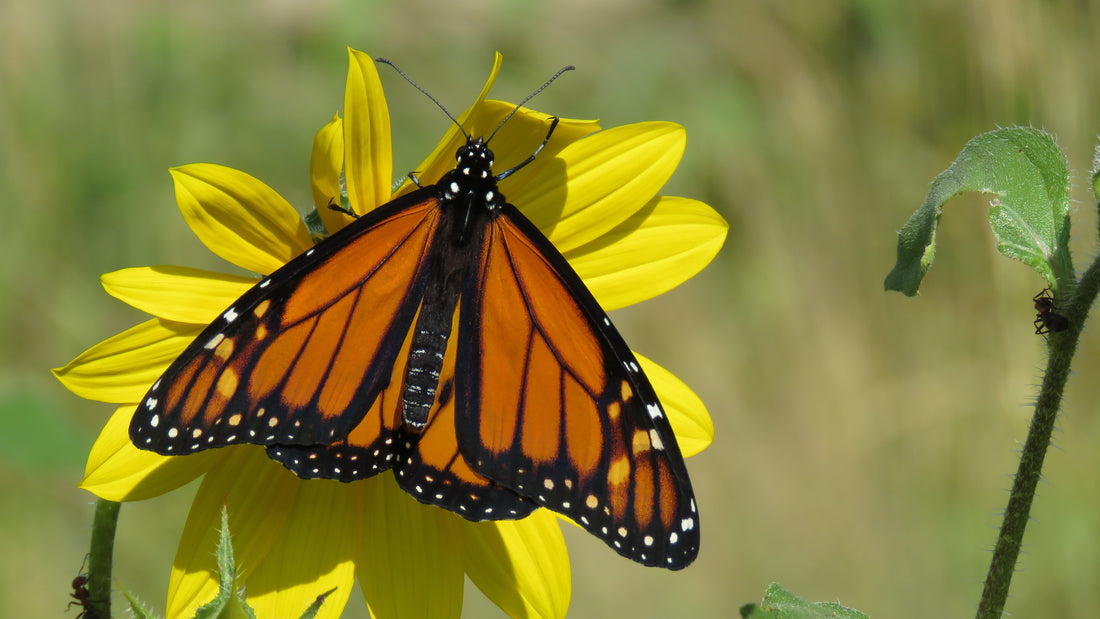
Butterflies NEED Native Plants: A Look at the Monarch
Share
The Bitterroot Monarch Project is collecting data on the presence and timing of monarchs across the Bitterroot Valley. If you’d like to learn more about the western monarch in Montana, check out the links below, or contact Maggie at mhirschauer@mpgranch.com.
Many insects, including butterflies and bees, evolved over thousands of years in close connection with native plants. Many species are so closely linked with particular plant families, or even specific species, that their reproduction and survival depend on the presence of these host plants. The monarch butterfly’s dependence on milkweed is a wonderful example of this close connection forged between many plants and insects.
ONE OF THE BEST THINGS YOU CAN DO TO SUPPORT BUTTERFLIES AND BEES IS PLANT REGIONALLY NATIVE PLANTS.
There are over 100 species of milkweed native to North America. The most common species in western Montana is showy milkweed. It’s a pioneer species, meaning it does well in disturbed soil where it can grow quickly.

You find it often in ditches along the sides of the road, a dangerous place for a broadleaf plant. Often these milkweed populations are either sprayed with herbicide to reduce their growth or mowed during the peak of summer when monarchs are migrating through the region looking for plants on which to lay eggs. Can you spot the monarch egg on these showy milkweed flower buds?

The reduction of milkweed plants across the mid-west, as a result of sprawling industrial agriculture reliant on herbicide application, is one of the many threats migratory monarchs face.
Monarch populations are counted in winter when they congregate over relatively small areas of land in the thousands across the coast of California (Western population), or in the millions in forests in central Mexico (Eastern population).

The most recent overwintering count for the western monarchs was an abysmal 1,914 insects. This population has dropped 99.9% in the last 30 years. The US Fish and Wildlife Service projected (at a minimum) a 66% chance this western migratory population will be extinct in 10 years.
Monarch caterpillars only eat milkweed. When small, they chew crescent-shaped holes in the leaf to help drain the threatening sticky latex. When older, the larvae chow down on many parts of the plant and can consume entire leaves, parts of the seed pod, or flower buds.


Monarchs are facing many threats, but if they are to make a rebound, one thing is certain: they are going to need milkweed! Planting milkweed AND also a diverse array of native plants that bloom at various times is a great way to support all insects. Monarchs need nectar to fuel their southward migration. Planting species that bloom into the fall is one way to help them on their journey.
Here are just a few examples of other butterfly species and their larval host plants:
|
butterfly |
larval host plants |
|
Western tiger swallowtail |
aspens, poplars, willows, alders |
|
Sara orange tip |
mustards |
|
clouded sulphur |
clovers, alfalfa |
|
American copper |
sorrels, docks |
|
silvery blue |
lupines and other legumes |
|
mourning cloak |
willows, aspens, elms, birches, hackberry |
|
Milbert’s tortoiseshell |
nettles |
|
great spangled fritillary |
violets |
(Information in chart above gathered from Stokes Butterfly Book: The Complete Guide to Butterfly Gardening, Identification, and Behavior by Donald and Lillian Stokes and Ernest Williams)
The Bitterroot Monarch Project is collecting data on the presence and timing of monarchs across the Bitterroot Valley. If you’d like to learn more about the western monarch in Montana, check out the links below, or contact Maggie at mhirschauer@mpgranch.com.
Western Monarch Advocates: Montana Updates
https://www.westernmonarchadvocates.com/montana
MPG Ranch, Bitterroot Monarch Project 2020 update
https://www.mpgranch.com/research/2020-monarch-sightings-2020-update
Xerces Society, Western Monarch Conservation
https://xerces.org/monarchs/western-monarch-conservation

